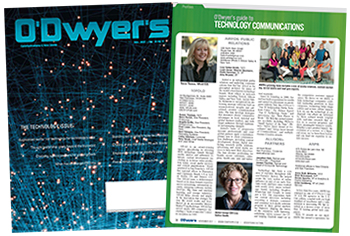|
|
Making technology meaningful, approachable and embraceable is the holy grail for every tech communications professional. Twenty plus years ago, the tools and channels for PR pros to share their stories were simple, push-oriented and one-dimensional. Press releases were the primary vehicle used by PR pros to convey a news announcement. The only visual media at play were broadcast TV and advertising. Websites didn’t exist, as bizarre as that seems now.
Today, PR has evolved and expanded to include many new ways of relating to the public. It’s about figuring out how their story fits into conversations already taking place amongst a plethora of other channels and media. Its success, therefore, is based on being integrated with those other channels and campaign elements, requiring PR counselors to be more informed of all the avenues available to them and take a broader view. PR as a function can’t work in a silo because it won’t be as effective. Nowhere is this more the case than in the technology industry, where tech PR is undergoing a revolution.
|
|
Today, technology lives within healthcare devices, educational learning tools, payroll systems, travel accessories, fashion and even inside art. Often, the benefits of technology are misunderstood. The current hype cycle around artificial intelligence, machine learning, driverless cars and robotics is just beginning. Innovation can be complex and intimidating to businesses and consumers alike, therefore requiring a more thoughtful, multi-faceted communications approach. Our role as tech communicators is of profound importance here. How we position and communicate the benefits of a new technology can be the difference between smooth consumer adoption or the rapid demise of yet another tech start-up.
In this new tech PR landscape, the greater the complexity, the greater the need for digital/ visual communications to simplify, explain and achieve buyer acceptance. Tech campaigns should incorporate all these elements: websites, videos, infographics and the use of virtual reality within immersive events. PR can still be “king” especially in thought leadership campaigns. It can create “virality” to advance conversations on social media and it can be the place where campaigns begin: a powerful engine that augments paid strategies across multiple platforms.
As a result, agencies are evolving their firms to offer more of these communications elements and brand marketers are changing how their marketing and communications teams are structured. For many firms, it means learning to speak a new language, hiring new people with broader skill sets and creating new processes around integrated service paradigms. It means getting out of the comfort zone and thinking multi-dimensionally.
So, where do you start when you want to get off the desert island?
First, identify the central objective your company wants to achieve, and the key problem your product or service solves. Then, articulate how it solves that specific problem differently. Who are the audiences? Where do they get their information? How open minded are they to something new and what existing beliefs might be in the way? Who influences their habits? These and other questions feed the research to fuel your strategy. Then, what are the story arcs you want to tell? You can have several, and they can run in parallel or in a sequence. And finally, from everything in the wheelhouse of communications (written, spoken, digital/visual), what are the tactics that bring those stories to life?
In a basic hypothetical example, a marketer of enterprise-level security software has to reach multiple audiences with clear messaging. Customers in the cyber world typically don’t like to divulge their security issues and won’t be of much help with endorsements. Earned media by way of a thought leadership campaign around digital resilience with contributed content is part of a carefully devised PR strategy that drives social activity. That company must also simultaneously manage the messaging conveyed via its website, its billboards and its print ads. Those messages are all intimately intertwined and are clearly more powerful in brand building if they convey the same story.
In another example, how we talk to consumers about robots that help us do our chores at home spans all types of media and channels. The use of love-based or positive marketing strategies to help assuage the emotions of fear associated with robotics can be instrumental and must be infused in every digital and analog aspect of this communications campaign. Without a healthy advertising budget, videos and infographics and some clever writing can be embedded in a creative social campaign targeting audiences on Facebook, and a radio morning talk show circuit. Traditional PR elements hang off this program, leveraging it, driving it, supporting it.
In sum, everything we do today as tech PR professionals needs to be connected and integrated within the broader communications mix. This presents a tremendous opportunity for tech PR people: the chance to relate to different publics in multiple ways, for the purpose of bringing acceptance to innovation. It is beautiful, complicated, intelligent and purposeful. Those that leave their desert island may find choppy waters but will soon hit their stride in an exciting new phase of their profession.
***
Sabrina Horn is Managing Director of Finn Partners’ Technology Practice.

 Sabrina Horn
Sabrina Horn

 Laura Anderson, who rose to VP/GM of global communications and events in a nearly 20 year stint at Intel, will take on the Americas technology chair at Burson following the completion of the BCW and H+K merger on July 1.
Laura Anderson, who rose to VP/GM of global communications and events in a nearly 20 year stint at Intel, will take on the Americas technology chair at Burson following the completion of the BCW and H+K merger on July 1. WE Communications has partnered with ROKK Solutions to form the WE ROKK AI service.
WE Communications has partnered with ROKK Solutions to form the WE ROKK AI service. In the dynamic world of modern business, effective communication is a pivotal tool for success across various industries. At Communications Strategy Group (CSG®), our expertise in embracing innovation in communication extends beyond traditional marketing strategies, paving the way for transformative industry-specific solutions.
In the dynamic world of modern business, effective communication is a pivotal tool for success across various industries. At Communications Strategy Group (CSG®), our expertise in embracing innovation in communication extends beyond traditional marketing strategies, paving the way for transformative industry-specific solutions. There are two types of tech PR professionals. Which one are you? And are C-suite executives making that decision for you?
There are two types of tech PR professionals. Which one are you? And are C-suite executives making that decision for you? While there’s an impulse to grab reporters’ attention with the newest industry-transforming tech product or service, a back-to-basics approach focused on telling the right stories to the right people is a far more successful way to ensure your technology campaign breaks through the clutter of today’s crowded tech landscape.
While there’s an impulse to grab reporters’ attention with the newest industry-transforming tech product or service, a back-to-basics approach focused on telling the right stories to the right people is a far more successful way to ensure your technology campaign breaks through the clutter of today’s crowded tech landscape.


 Have a comment? Send it to
Have a comment? Send it to 
No comments have been submitted for this story yet.